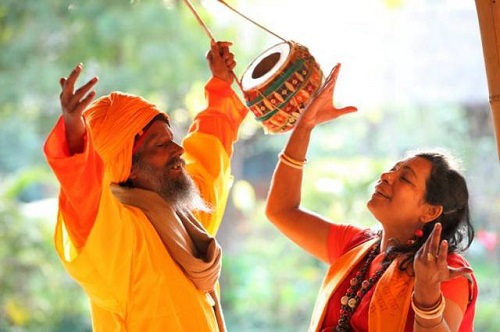By
Chandrani Banerjee
Bauls – a loosely knit Indian community living a life beyond social norms on basics earned through folk singing- are slowly falling for the glitter of the west. A baby step towards a fancy lifestyle with added recognition and acknowledgement is amusing them.
Mimlu and Paban Das Baul are a couple living in France for the last three decades. Both write and make Baul folk music. “Paban is a big hit. His music is on local FM radio and people consider him a big star. In India this is his first album being produced,” says Mimlu.
Westerners enjoy the local folk originating from Gorbangha, Shantiniketan, Bolpur, from India’s West Bengal. Their attire of multiple cloth patches with a dotara (a handmade wooden musical instrument with two strings) in hand to sing along has a huge impact. There are several people of the western origin who find it assuring to live with the members of the community.
A sudden visit to Bolpur or Gorbangha often reveals a baithak of foreigners surrounding freewill Baul singers. They share drink, food and lives. Then there are offers to travel abroad and perform. However some reject it considering the philosophy of their community to remain content with basics. But recent trends show that Baulsingers do aspire for the big ticket.
Bishnu Das Baul (45), who performs in Kolkata to make his living, points out, “Of course, I want to travel abroad. Dreams occasionally turn into reality. I am hoping that one day all this will come true although at times I find my age going against it.”
The Baul community does not complain but are happy and look forward to such offers that will give them opportunities to perform and stay abroad.
“Yes, they do get carried away by the glitter and shimmer of the western world. They are human. The Baul singers have been performing abroad for a long time. I have a Baul friend in Shantiniketan who has a Swedish wife. He performed all along the west. I do not think there is anything wrong. Do they have anything here in India?” questions Partha Majumdar, a researcher working on the Bauls for a decade.
“They have found a substantial way to survive with dignity and respect. The west recognized their music making, their Bedouin lifestyle and respected them. So it is only human to aim for such platform,” he adds.
Sadhan Das Baul has a Japanese wife and there are several such Baul singers who decided to shuffle between the shores to earn a fancy living. Sadhan Das Bauland Maki Kazumi hosts international tents in Kenduli Mela every year in Kolkata. Dipankar Chaki, popularly known as Jojo, a national award winning sound arranger with Tollywood and producer of Paban Das Baul’s fusion music album says, “The current trend is to stay partly in Europe and Kolkata.”
Many believe that this traditional art needs more attention from the authorities concerned. Banglanatok.com is an organization working for promotion of traditional art forms.“Shilpi Banchle Shilpo Banchbe (If we could save artists then only the art will survive). There are few Baul singers I can name who make a decent living. Most of them are struggling to eke out a living. We have economically rehabilitated the Baul singers of Gorbangha village. But there is a scope to do more,” says director Ranjan Sen.
Kolkata organizes music festivals like Baul Fakir Utsav, Poetry Couture from December to January. They get an opportunity to perform on these limited platforms. Organizer of Poetry Couture and part time English professor of Jadavpur University Joie Bose says, “They sometimes get to perform at private parties and programs where in creativity without a restriction of structured music is welcomed.” Sumonto Das Baul, a second generation Baul operating from Shantiniketan, laments, “I am into singing since childhood. I would be happy if I could send my children to school even if it is just to learn music. Life would be easy for them.”
“The world is changing and they aspire to live a better life. There is nothing wrong in it,” claims Majumdar who organizes Baul Fakir Utsav. Many feel that the introduction of modern instruments with the traditional dotara negatively contributed towards the erosion of Baul melody. However the ‘Baul world’ is such an open concept that this is something inevitable. “Fusion is something that the world and India have looked forward to. They love the amalgamation of folk with modernity. I think the world is changing and so is Baul Music,” says Chaki.
Changing indeed as Paban and Mimuli’s kids have taken up different vocations though they grew up amid Baul folk music. They have a different world but the jam sessions are marked by their corporate friends joining in.
Origin of Baul
Baul music is a widely known and appreciated folk music of Bengal. It is basically a Bengali religious sect whose members call themselves Baul and their songs are called Baul-Gan (baul songs). It has been suggested that, etymologically, the word derives from the Sanskrit word “vatula” meaning “affected by the wind disease, mad”. On the other hand, it might be derived from the Sanskrit word “vyakula” meaning “restless, disordered”.
The Baul costume comprises a half-dhoti and an alkhalla (saffron robes). Another noticeable aspect is their hair style. They don’t cut their hair but coil it neatly atop the head in a bun. They also wear a necklace made of beads formed from the stems of the basil plant (tulsi).
In Bengali folk music – Baul, Bhaoyaiya and Bhatiyali – Baul is distinguished from the others textually as religious music. The texts of bhatiyali and bhaiyaiya, though they may be concerned with Radha and Krishna, are mainly about the problems of love, separation or unrequited love.
In Baul-gan, however, though songs of similar nature occur, they are thought of as allegories on the state of separation between the souls of men and spiritual ground. The instruments, extensively used by the Bauls are gopiyantro, khamak, dotara, ghungur, nupur and duggi.
Gopiyantro, often called “ektara” means one string and that is the most popular instrument of a Baul singer. The Ghungur or Nupur are always used in conjunction with Gopiyantro or Khamak. The Baul singers also use “dotara” (two strings) as their paraphernalia. Khartal/mandira and premjuri are used as the adjunct idiophones by the singers.
Why Fusion is in Vogue
Fusion of Baul Music with electric guitar and modern arrangements has been a hit in the western world. The local music bands and street performers in many countries have joined hands with Baul Fakirs to produce albums.
Researchers feel that the west needs good foot tapping music that suits the temperament and yet has a calming effect. Baul fusion gives them the calming effect with something fresh.
A section of experts, however feel that this introduction is taking away the soul of Baul music. The real Baul folk is all about voice where instruments are hardly audible.
Kolkata based Ranjan Sen, who is working for the rehabilitation of various art forms in West Bengal, says, “Introduction of electronic instruments have spoiled the real music. Not that every person from West is travelling to villages in search of real music.”
Countering him, Partha Mujumdar, an organizer of Baul Fakir Utsav in Kolkata claims that since the Indian government could not provide much support to promote the Baul talent, the latter have every right to go wherever they get an opportunity. “It is only the right and fair thing to accept such offers and enjoy music and good life,” he says.
Recently a programme ‘Rock and Baul’ has caught the fancy of people in Kolkata to promote fusion. Baul singers are also a hit at private parties where they fuse with Bangla modern songs.
Chandrani Banerjee
Chandrani Banerjee is a Journalist with nearly 15 years of experience, having worked previously as Special Correspondent for Outlook Magazine, where she exposed and was the first to get the confessional documents of Pakistani-American double agent David Coleman Headley’s involvement in the 2008 Mumbai terrorist attacks. The news was followed extensively in international media. She also did the last interview of Central Indian state’s city Bhopal-based Right to Information Act (RTI) activist Shahela Masood’s in which she mentioned how she feared for her life. Shortly after its publication, Masood was shot dead and it became a major national news.
Chandrani also broke the story about the Indian government’s plan to exempt the Central Bureau of Investigation (CBI) from the ambit of the Right to Information (RTI) Act, which was widely debated in the national media, as well as scooping the inquiry report on former Chief Justice of Sikkim High Court, Justice Dinakaran, which spelt out specific corruption charges against him, and an exclusive report on the Supreme Court provident fund scam corroborated with details from chargesheet (an official legal document or confession by the accused) after she accessed the chargesheet that indicted several apex judges in the scam.
In addition to earlier roles within The Citizen Online, the Press Trust of India, the Mail Today, Sahara Samay Rashtriya, Indo-Asian News Service, Zee TV and The Asian Age, Chandrani has written a coffee table book ‘Imli’, based on the stories of women on the streets of Delhi. The book aims to highlight the pain, agony and distress of these women while also underlining the apathy and negligence of the government on their plight. The book is endorsed by the United Nations and was released at the organisation’s New Delhi headquarters on the occasion of International Women’s Day in 2011.



No Comments Yet!
You can be first to comment this post!